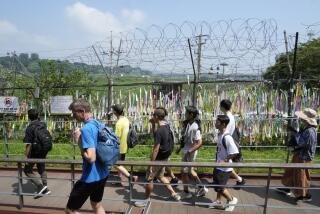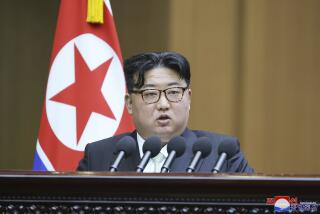Seoul to Bail Out N. Korea Tourist Project; Rescue May Cost Millions
- Share via
TOKYO — The financially ailing Mt. Kumgang tourism project--one of the largest capitalistic ventures in North Korea and a symbol of inter-Korean cooperation--will be bailed out by the South Korean government, officials in Seoul said Wednesday.
Rescuing the project, which had been funded by the Hyundai conglomerate, may cost as much as $22 million. The bailout is the latest sign that the South is putting more effort than the North into improving relations between the two nations.
That the Mt. Kumgang project requires a bailout is testament to the growing pessimism about prospects for reconciliation on the Korean peninsula. It also speaks to the difficulty of doing business with the nation known as the Hermit Kingdom.
Hopes for peace soared after the historic summit between leaders of the two Koreas a year ago, but in recent months, optimism has waned.
North Korean leader Kim Jong Il hasn’t made good on his promise to travel to the South, to reciprocate for President Kim Dae Jung’s trip to the North last June. The U.S. military has reported an increased North Korean troop presence near the heavily fortified zone that divides the two Koreas, which technically remain at war. And construction of the inter-Korean railroad the two leaders agreed to build has all but stopped on the North Korean side, officials say.
Meanwhile, only a few hundred of the estimated 1 million families that split when war divided the peninsula 50 years ago have been able to reunite since the summit, far fewer than South Korea had hoped.
In the case of the Mt. Kumgang project, the North refused to cancel the access fees Hyundai agreed to pay for letting tourists visit the mountains, a beautiful range famous throughout the region.
Hyundai had paid $342 million to North Korea as of last year, including $156 million for allowing its chartered passenger ships to dock near the range and $126 million to build facilities at the landing site.
But Hyundai, whose late chairman was born in the North and was determined to set up business there, has lost about $340 million since the tours began in November 1998.
The venture has brought Hyundai $230 million in revenue. The company had estimated that half a million tourists would visit the area annually, but only slightly more than 180,000 have made the three-day, two-night journey. North Korea requires that passengers travel only at night, in passenger ships, and that they sail to international waters before doubling back.
Beset by financial woes, Hyundai failed to make a $46-million payment to North Korea that was due last month. The regime in Pyongyang later agreed to reduce the payment to $22 million, but Hyundai still couldn’t make good on it.
The South’s state-run Korea National Tourism Organization, or KNTO, will take over the project, in which Hyundai’s Asan Co. unit will still be involved.
KNTO President Cho Hong Kyu said his agency will borrow money from banks to pay the overdue fees and hopes to also make use of about $40 million from the government’s South-North Cooperation Fund to invest in and expand the venture.
The South is trying to persuade Pyongyang to change the fee it charges for access--currently a fixed sum--to one based on the number of visitors.
The bailout triggered outrage from the opposition Grand National Party, which denounced the government for wasting taxpayer money.
“Hyundai collapsed because of the deficit from the project,” said Kim Ki Bae, GNP secretary-general. “That the state-owned KNTO is participating . . . means that the government will pour taxpayers’ money into a bottomless pit.”
A spokesman for the ruling Millennium Democratic Party said the Mt. Kumgang project is too symbolic to let fail and is the price for peace.
“Before the Mt. Kumgang project, there were North Korean submarines infiltrating the east and west coast,” said the senior official, who asked not to be named. “After the tour project, there has been no such infiltration.”
“Think about the cost involved to mobilize military troops to hunt infiltrators, the loss of weeks of business for fishermen in the area and the setback to the tourism business,” he added. “The money paid to North Korea for the project is a very good and practical investment.”
*
Chi Jung Nam of The Times’ Seoul Bureau contributed to this report.
More to Read
Sign up for Essential California
The most important California stories and recommendations in your inbox every morning.
You may occasionally receive promotional content from the Los Angeles Times.













